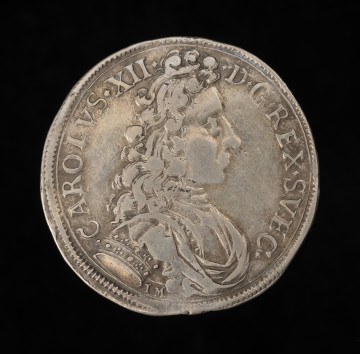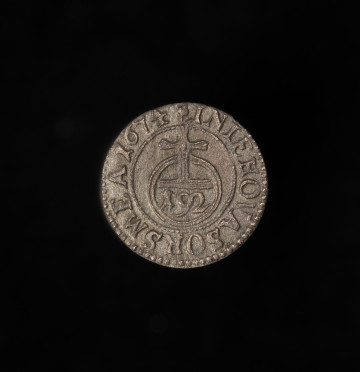
2/3 of a thaler (gulden)
1706
National Museum in Szczecin
Part of the collection: Pomeranian coins
During the reign of Charles XI (1660–1697) in Swedish Pomerania, rising silver prices led to the collapse of the monetary system, which had been based on the Holy Roman Empire’s 9-thaler minting standard from 1559. In 1667, a new 10.5-thaler standard was introduced at the Treaty of Zinna, expanding the range of denominations in circulation. A new coin, valued at 2/3 of a thaler and known as the silver gulden, was introduced to stabilise the system. It was minted from twelve-lötige silver (750 fine). Smaller silver coins were issued in proportion to this standard, while thalers were minted only in limited quantities, adhering to the Empire’s traditional standard. The mint in Szczecin changed hands frequently, with several different mintmasters in charge. At the end of 1685, David Heinrich Matthäus, previously the mint’s controller, was appointed as mintmaster. His initials (DHM) appeared on all coins struck under his tenure. The mint’s output focused heavily on 2/3 thalers and 1/3 thalers, though both were minted with a slightly lower silver content than required by the Zinna standard. In less than three years under Matthäus’ management, over 200,000 Reichsthalers worth of silver was converted into these two denominations. Both coins shared a similar design. The obverse depicted the bust of the king with his Swedish title, while the reverse featured the grand coat of arms of the Duchy of Pomerania. The inscription on the reverse identified the coin as an issue struck by Sweden for Western Pomerania (Pomeraniae Citerioris). The 2/3 thaler of Charles XI is found in many museum and private collections. However, technical and staffing issues at the Szczecin mint are evident in the coin’s appearance. The most noticeable flaws include rough portraits, scratches, and irregularities on the die surface. Despite the mintmaster’s requests to hire a skilled engraver and purchase a new rolling press – estimated at around 500 Reichsthalers – the provincial authorities rejected these proposals for cost-saving reasons. Genowefa Horoszko
Author / creator
Object type
coin
Technique
coining
Material
silver
Origin / acquisition method
purchase
Creation time / dating
Creation / finding place
Owner
The National Museum in Szczecin
Identification number
Location / status

1706
National Museum in Szczecin

1674
National Museum in Szczecin

1707
National Museum in Szczecin
DISCOVER this TOPIC
National Museum in Szczecin
DISCOVER this PATH
Educational path